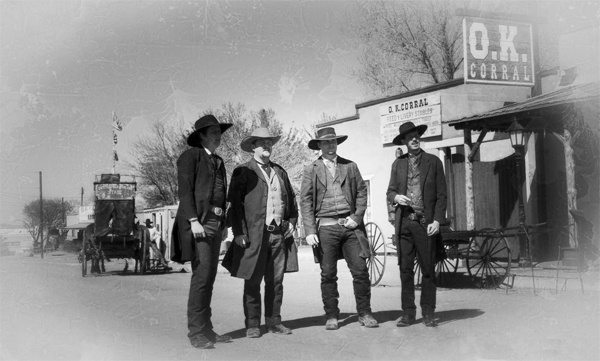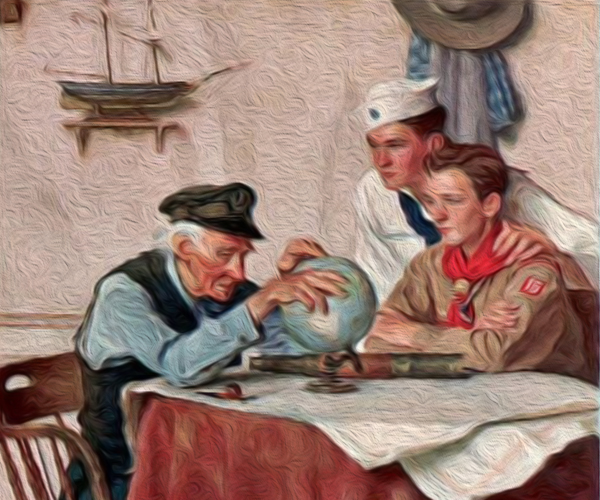
Shootout at the OK Corral on October 26, 1881
Shootout at the OK Corral: On this day in 1881, the Earp brothers face off against the Clanton-McLaury gang in a legendary shootout at the OK Corral in Tombstone, Arizona.
After silver was discovered nearby in 1877, Tombstone quickly grew into one of the richest mining towns in the Southwest. Wyatt Earp, a former Kansas police officer working as a bank security guard, and his brothers, Morgan and Virgil, the town marshal, represented “law and order” in Tomb”tone, though they also had reputations as being power-hungry and ruthless. The Clantons and McLaurys were cowboys who lived on a ranch outside of town and sidelined as cattle rustlers, thieves and murderers. In October 1881, the struggle between these two groups for control of Tombstone and Cochise County ended in a blaze of gunfire at the OK Corral.
On the morning of October 25, Ike Clanton and Tom McLaury came into Tombstone for supplies. Over the next 24 hours, the two men had several violent run-ins with the Earps and their friend Doc Holliday. Around 1:30 p.m. on October 26, Ike’s brother Billy rode into town to join them, along with Frank McLaury and Billy Claiborne. The first person they met in the local saloon was Holliday, who was delighted to inform them that their brothers had both been pistol-whipped by the Earps. Frank and Billy immediately left the saloon, vowing revenge.
Around 3 p.m., the Earps and Holliday spotted the five members of the Clanton-McLaury gang in a vacant lot behind the OK Corral, at the end of Fremont Street. The famous gunfight that ensued lasted all of 30 seconds, and around 30 shots were fired. Though it’s still debated who fired the first shot, most reports say that the shootout began when Virgil Earp pulled out his revolver and shot Billy Clanton point-blank in the chest, while Doc Holliday fired a shotgun blast at Tom McLaury’s chest. Though Wyatt Earp wounded Frank McLaury with a shot in the stomach, Frank managed to get off a few shots before collapsing, as did Billy Clanton. When the dust cleared, Billy Clanton and the McLaury brothers were dead, and Virgil and Morgan Earp and Doc Holliday were wounded. Ike Clanton and Claiborne had run for the hills.
Sheriff John Behan of Cochise County, who witnessed the shootout, charged the Earps and Holliday with murder. A month later, however, a Tombstone judge found the men not guilty, ruling that they were “fully justified in committing these homicides.” The famous shootout has been immortalized in many movies, including Frontier Marshal (1939), Gunfight at the OK Corral (1957), Tombstone (1993) and Wyatt Earp (1994).
History Channel / Wikipedia / Encyclopedia Britannica /O.K. Corral / National Geographic.org / Library of Congress.gov
/ Shootout at the OK Corral on October 26, 1881 (YouTube search) 

Understanding Military Terminology - Midcourse Phase
(DOD) That portion of the flight of a ballistic missile between the boost phase and the terminal phase. See also boost phase; terminal phase.
Joint Publications (JP 3-01) Countering Air and Missile Threats.)

The Old Salt’s Corner
“Tales of Legendary Ghost Ships”
Legend of The Flying Dutchman, Ghostly Apparition of The Ship of Captain Hendrick
Among nautical myths and legends, few are as famous as the Flying Dutchman. Many have claimed to see the ghostly vessel of Captain Hendrick van der Decken (the Dutchman) since it sank in 1641. It is because of his brash attitude in the face of God’s stormy wrath that Captain van der Decken and his crew are cursed to sail the high seas until doomsday.
Captain van der Decken had made the perilous journey from Holland to the Far East Indies in order to purchase lucrative goods like spices, silks, and dyes. There had been close calls of course but they eventually arrived. After purchasing as much as the hull could hold and having made the necessary repairs to the ship, captain van der Decken set out for Amsterdam. As his ship rounded the coast of Africa, captain van der Decken thought of how convenient it would be if his employers, the Dutch East India Company, made a settlement near the Cape of Good Hope in South Africa to serve as a respite from the turbulent waters.
Voyage and Curse
The Captain was deep in thought as his man-of-war ship began to round the Cape. Suddenly, a terrible gale sprung up, threatening to capsize the ship and drown all aboard. The sailors urged their captain to turn around but Captain van der Decken refused. Some say he was mad, others say he was drunk but for whatever reason, the Captain ordered his crew to press on. He lit his pipe and smoked as huge waves crashed against the ship. The winds tore at the sails and water spilled down into the hull. Yet the Captain “held his course, challenging the wrath of God Almighty by swearing a blasphemous oath” (Occultopedia, 2016).
Pushed to their limit, the crew mutinied. Without hesitation, Captain van der Decken killed the rebel leader and threw his body into the turning seas. The moment the rebel’s body hit the water, the vessel spoke to the Captain “asking him if he did not mean to go into the bay that night. Van der Decken replied: ‘May I be eternally damned if I do, though I should beat about here till the day of judgment’” (Wagner quoted in Music with Ease, 2005).
At that, the voice spoke again saying, “As a result of your actions you are condemned to sail the oceans for eternity with a ghostly crew of dead men bringing death to all who sight your spectral ship and to never make port or know a moment’s peace. Furthermore, gall shall be your drink and red hot iron your meat.” At this, Captain van der Decken did not quaver for an instant. Instead he merely cried “Amen to that!” (Occultopedia, 2016).
An Undersea Mystery: The Accidental Discovery of the Ghost Ship in the Baltic Sea.
Malevolent Phantoms, Corpse Brides, and Ancestor Spirits: The Ancient Belief in Ghosts.
Ghost Ship
Since then, Captain van der Decken has been given the moniker the Flying Dutchman, sailing his ghost ship the world over. Sailors claim the Dutchmen has led ships astray, causing them to crash on hidden rocks or reefs. They say that if you look into a fierce storm brewing off the Cape of Good Hope, you will see the Captain and his skeletal crew. But beware, legend has it that whoever catches sight of the Dutchman will most certainly die a gruesome death.
The legend of the Flying Dutchman first gained widespread popularity with Wagner’s 1843 opera, The Flying Dutchman. Yet, the reason the legend has endured so long and has been the subject of so many retellings (seen in or inspiring not only Wagner’s opera but also Coleridge’s The Rime of the Ancient Mariner, Pirates of the Caribbean, a SpongeBob Square Pants character, a Scooby-Doo episode, and more) is because there have been so many supposed sightings of the ghost ship.
The Mystery of the Mary Celeste: Crew Vanishes from Seaworthy Ship.
600-Year-Old Royal Ship of Henry V Found Buried in Hampshire River.

“I’m Just Sayin”
“If something cannot go on forever, it will stop. If a trend cannot go on forever, there is no need for action or a program to make it stop, much less to make it stop immediately; it will stop of its own accord.”
~ Stein's law.

“Thought for the Day”
“It is one of the ironies of our time
that while concentrating on the defense of our country
against enemies from without,
we should be so heedless of those
who would destroy it from within.”
~ Rachel Carson

“What I Have Learned”
“Being honest
may not get you a lot of friends
but it’ll always get you the right ones.”
~ Anonymous

Bizarre News (we couldn’t make up stuff this good – real news story)

Cops accused of storing dead bodies in MTA employee break rooms
Stand clear of the dead bodies.
“Leaking” corpses of people killed by subway trains are often brought to employee lunch rooms and other break areas inside stations, disgusted union officials and sources said Monday.
In an effort to restore service quickly, bodies are simply carted off to “whatever room happens to be nearest”,
“If a lunch room is the nearest, they’ll put it in the lunch room”, the source said.
New York Post (08/14/2017) 

Mr. Answer Man Please Tell Us: If Beer and Bread Use Almost the Exact Same Ingredients, Why Isn't Bread Alcoholic?
All yeast breads contain some amount of alcohol. Have you ever smelled a rising loaf of bread or, better yet, smelled the air underneath dough that has been covered while rising? It smells really boozy. And that sweet smell that fresh-baked bread has under the yeast and nutty Maillard reaction notes? Alcohol.
However, during the baking process, most of the alcohol in the dough evaporates into the atmosphere. This is basically the same thing that happens to much of the water in the dough as well. And it’s long been known that bread contains residual alcohol—up to 1.9 percent of it. In the 1920s, the American Chemical Society even had a set of experimenters report on it.
Anecdotally, I’ve also accidentally made really boozy bread by letting a white bread dough rise for too long. The end result was that not enough of the alcohol boiled off, and the darned thing tasted like alcohol. You can also taste alcohol in the doughy bits of underbaked white bread, which I categorically do not recommend you try making.
Putting on my industrial biochemistry hat here, many [people] claim that alcohol is only the product of a “starvation process” on yeast once they run out of oxygen. That’s wrong.
The most common brewers and bread yeasts, of the Saccharomyces genus (and some of the Brettanomyces genus, also used to produce beer), will produce alcohol in both a beer wort and in bread dough immediately, regardless of aeration. This is actually a surprising result, as it runs counter to what is most efficient for the cell (and, incidentally, the simplistic version of yeast biology that is often taught to home brewers). The expectation would be that the cell would perform aerobic respiration (full conversion of sugar and oxygen to carbon dioxide and water) until oxygen runs out, and only then revert to alcoholic fermentation, which runs without oxygen but produces less energy.
Instead, if a Saccharomyces yeast finds itself in a high-sugar environment, regardless of the presence of air it will start producing ethanol, shunting sugar into the anaerobic respiration pathway while still running the aerobic process in parallel. This phenomenon is known as the Crabtree effect, and is speculated to be an adaptation to suppress competing organisms
in the high-sugar environment because ethanol has antiseptic properties that yeasts are tolerant to but competitors are not. It’s a quirk of Saccharomyces biology that you basically only learn about if you spent a long time doing way too much yeast cell culture.
Brew Enthusiast
• Food Babe
• Forbes
• Quara
• Wikipedia


NAVSPEAK aka U.S. Navy Slang
Pushbutton: Term applied to a 6 year enlistee with advanced schooling. The Enlistee is immediately granted E-3 rank upon completion of basic training, and E-4 rank upon completion of “A” school. Frequently the Enlistee also has an opportunity to extend to 8 years, and immediately gain E-5 rank within 2-3 years total service, like “pushing a magic button to gain rank.”
Pussy patch: Transdermal scopolamine patch for seasickness.
Pussy pills: Seasickness pills.


Just for you MARINE
Shooter: Person whose primary duty involves marksmanship with a rifle or pistol, such as students at a rifle range or competition team members.
Shore Party: Landing support specialists that direct the disposition of troops during an amphibious assault.
Short-timer: Person nearing the completion of his/her present tour of duty or enlistment.
Short-timer's Disease: Apathy to duties and regulations from a person nearing End of Active Service (EAS).

Naval Aviation Squadron Nicknames
VAQ-209 - “Star Warriors”
USNR Tactical Support Wing, Naval Air Station Whidbey Island, Washington - Established October 1, 1977

Where Did That Saying Come From?

“Caught Red-Handed” Meaning: To be caught in the act of committing a misdemeanour, with the evidence there for all to see.
The Red Hand has long been a heraldic and cultural symbol of the northern Irish province of Ulster. One of the many myths as to its origin is the tale of how, in a boat race in which the first to touch the shore of Ulster was to become the province's ruler, one contestant guaranteed his win by cutting off his hand and throwing it to the shore ahead of his rivals. The potency of the symbol remains and is used in the Ulster flag, and as recently as the 1970s a group of Ulster loyalist paramilitaries named themselves the Red Hand Commandos.
Red-handed doesn't have a mythical origin however - it is a straightforward allusion to having blood on one's hands after the execution of a murder or a poaching session. The term originates, not from Northern Ireland, but from a country not so far from there, socially and geographically, that is, Scotland. An earlier form of 'red-handed', simply 'red hand', dates back to a usage in the Scottish Acts of Parliament of James I, 1432.
Red-hand appears in print many times in Scottish legal proceedings from the 15th century onward; for example, this piece from Sir George Mackenzie's A discourse upon the laws and customs of Scotland in matters criminal, 1674:
“If he be not taken red-hand the sheriff cannot proceed against him.”
The earliest known printed version of 'red-handed' is from Sir Walter Scott's Ivanhoe, 1819:
“I did but tie one fellow, who was taken redhanded and in the fact, to the horns of a wild stag.”
Scott was an avid student of Scottish history and folklore, which he relentlessly mined for inspiration in his novel writing. He is certain to have heard 'redhand' before writing Ivanhoe. The step from 'redhand' to 'redhanded' isn't large, so calling Scott the originator of the term is perhaps being over generous to him. Nevertheless, the enormous popularity of his books certainly brought 'red-handed' to a wide audience and, without him, the term might now be long forgotten.
Phrases.org UK

Science & Technology

'Game of Thrones' Science: Could a Person Ride a Dragon?
• Watch This F-14 Tomcat Spin Out of Control
• How Mega-Ships Drop Their Giant Anchors
• Add One Ounce Science: How to Hack Your Booze - All the (weird) things you can do to liquor to make it taste great
• One of These Planes Will Be the Air Force's New Light Attack Aircraft
• What Will Happen in the Next 100 Trillion Years?
• What Makes Submarines So Quiet - The science of how subs elude their enemies, explained
Popular Mechanics

The Strange, Mysterious or Downright Weird

A supersecret sonic weapon being used to attack diplomats in a foreign country may sound like the start of a sci-fi novel, but that's exactly what several U.S. diplomats in Cuba may have been exposed to, the U.S. State Department recently announced.
The physical symptoms, which the State Department would not confirm, but which some news reports have suggested included hearing loss, got so bad that some of these officials had to be recalled from their duties in Havana.
“Some U.S. government personnel who were working at our embassy in Havana, Cuba, on official duties — so they were there working on behalf of the U.S. embassy there - they've reported some incidents which have caused a variety of physical symptoms”, Heather Nauert, a spokeswoman for the State Department.
After an extensive investigation, U.S. officials determined that a secret sonic weapon was to blame. [Mind Controlled Cats?? 6 Incredible Spy Technologies]
What we know
The strange symptoms emerged in the fall of 2016, when several employees at the U.S. embassy in Havana began complaining of physical symptoms. Many of the individuals were new to the embassy and some had to return to the United States because of the severity of their symptoms - the details of which have yet to be disclosed. An investigation by the U.S. government concluded that the symptoms could be attributed to a device that operated outside the audible hearing range and was used somewhere, possibly in their houses, Time magazine reported. Right now, there's no word on whether these devices were deliberately used. [Flying Saucers to Mind Control: 22 Declassified Military & CIA Secrets]
Hard of hearing
There are so many details missing in this story that it's hard to explain exactly what the device could be, Liberman said. However, sound-induced hearing loss requires that the mechanical part of the ear that senses audible sound be overloaded.
Infrasound
However, it's possible the devices somehow generate infrasound - the type of low-frequency sound given off by windmills or wind generators with the beating of the blades. Infrasound is below the human hearing range. See: 10 Odd Causes of Headaches.
High-frequency ultrasound
The other type of sound humans can't hear is ultrasound, which is above 20 khz. That's a less likely possibility because high-frequency sound dissipates quickly with distance and in tissue such as the ear. However, high-intensity, focused ultrasound has been used for everything from breaking kidney stones to cauterizing tissues in the body.
Sonic weapons
While the idea of a silent sonic weapon sounds like something out of James Bond, Inspector Gadget or the reject pile of DARPA, the idea of using sound as a weapon has a long history.
Live Science (07/31/2017) 


SONG FACTS

“You Really Got Me” - The Kinks
Album: Fool for the City
Released 1964 
Ray Davies wrote this with the help of his brother (and Kinks guitarist) Dave. Ray played it for Dave on piano, and Dave tried it on guitar. Their first version was six-minutes long, but the final single release came in at just 2:20.
Dave Davies got the dirty guitar sound by slashing the speaker cone on his amp with a razor blade. The vibration of the fabric produced an effect known as “fuzz”, which became common as various electronic devices were invented to distort the sound. At the time, none of these devices existed, so Davies would mistreat his amp to get the desired sound, often kicking it. The amp was a cheap unit called an Elpico.
Before they released this, The Kinks put out two singles that flopped: a cover of “Long Tall Sally” and a Ray Davis composition called “You Still Want Me”. If “You Really Got Me” didn't sell, there was a good chance their record label would have dropped them.
When The Kinks heard the first version they recorded of this song, they hated the results. It was produced by Shel Talmy, their manager at the time, and Ray Davies thought it came out clean and sterile, when he wanted it to capture the energy of their live shows.
Dave Davies' girlfriend backed them up, saying it didn't make her want to “drop her knickers”. The Kinks' record company had no interest in letting them re-record the song, but due to a technicality in their contract, The Kinks were able to withhold the song until they could do it again. At the second session, Dave Davies slashed his amp and Talmy produced it to get the desired live sound. This is the version that was released.
The song was recorded on September 26, 1964 with Ray Davies on lead vocals, Dave Davies on guitar and Pete Quaife on bass.
The Kinks didn't have a drummer when they first recorded the song, so producer Shel Talmy brought in a session musician named Bobby Graham to play. When they recorded this the second time, Mick Avory had joined the band as their drummer, but Talmy didn't trust him and made him play tambourine while Graham played drums. One other session musician was used - Arthur Greenslade played piano.
Just before Dave Davies started his guitar solo at the second recording session, his brother yelled to encourage him. Dave got a little confused, but they had only three hours of studio time so he kept playing. He pulled off the solo despite the distraction.
The first line was originally “You, you really got me going”. Ray Davies changed it to “Girl, you really got me going” at the suggestion of one of their advisers. The idea was to appeal to the teenage girls in their audience.
This was the first hit for The Kinks. It gave them a lot of publicity and led to TV appearances, magazine covers, and two gigs opening for The Beatles. They didn't have an album out yet, so they rushed one out to capitalize on the demand. This first album contained only five originals, with the rest being R&B covers.
It was rumored that Jimmy Page, who was a session musician at the time, played guitar on this track, which the band stridently denied. According to a 2012 interview on Finding Zoso with producer Shel Talmy, Jimmy Page did not play the lead guitar on the song. However he did play rhythm as Ray Davies didn't want to sing and play guitar at the same time.
Ray Davies was 22 when they recorded this; Dave Davies was 17.
The powerful rhythm guitar riff was very influential on other British groups. The Rolling Stones recorded “(I Can't Get No) Satisfaction”  , which was driven by the rhythm guitar, a year later.
, which was driven by the rhythm guitar, a year later.
The Kinks' next single was “All Day And All Of The Night”  ,, which was basically a re-write of this song, but was also a hit.
,, which was basically a re-write of this song, but was also a hit.
The Kinks, official website / Billboard / All Music / Song Facts / Ultimate Classic Rock / Wikipedia
Image: “The Kinks (album)” by The Kinks

Trivia
The first brand of mascara for women, in 1915, was named after Maybelline, who was the sister of T. L. Williams who produced the product
Rotisserie Leagues is a tasty name for these sports leagues in which fans create fantasy teams and get points based on player accomplishments.
Peter and the Wolf. by Sergei Prokofiev is a musical piece for orchestra telling the story of a disobedient boy's encounter with a wild animal.
A Test for People Who Know Everything
From the Jeopardy Archives Category - “BOOKS BY CHAPTER TITLES” ($400):
“Queequeg in His Coffin”.
● Answer for People Who Do Not Know Everything, or Want to Verify Their Answer Shmoop
From the Jeopardy Archives Category - “BOOKS BY CHAPTER TITLES” ($800):
“The Country of the Quadlings”
● Answer for People Who Do Not Know Everything, or Want to Verify Their Answer YouTube
Answer to Last Week's Test
From the Jeopardy Archives Category - “HYBRID WORDS” ($200): (Each correct response will have a Greek and a Latin root.)
Your mechanic loves this word from the Greek for “self” & the Latin for “move”.
Answer: Automobile Learn That.org
From the Jeopardy Archives Category - “HYBRID WORDS” ($600):
The Greek for “tribe” & the Latin for “kill” gave us this crime that's investigated by the International Criminal Court.
Answer: Genocide Learn That.org

Joke of the Day
My Dog Did It Eat It
“Johnny, where's your homework?” Miss Martin said sternly to the little boy, while holding out her hand.
“My dog ate it”, was his solemn response.
“Johnny, I have been a teacher for eighteen years. Do you really expect me to believe that?”
“It's true, Miss Martin, I swear”, insisted Johnny. “I had to force him, but he ate it!”

“Frasier” (1993 - 2004)
Frasier Crane: “I am not crazy! I am dating a supermodel zoologist, whom I stole away from a professional football player, and she is off to the Galapagos Islands to artificially inseminate iguanas! Now is that so hard to believe?!”
Frasier Crane: “At Cornell University, they have an incredible piece of scientific equipment known as the "tunneling electron microscope." Now, this microscope is so powerful that by firing electrons, you can actually see images of the atom, the infinite decimally minute building block of our universe. Roger, if I were using that microscope right now, I still wouldn't be able to locate my interest in your problem.”
Dr.Niles Crane: “Oh God, Frasier, we've stumbled into Hell's waiting room!”
Dr.Niles Crane: “Good Lord! There's a bee out there the size of a wood finch!”
Frasier Crane: “I'm a babe magnet!”
Dr.Niles Crane: “...Did you say something? Your penis was talking so loud I couldn’t hear.”
~ “Frasier” (1993 - 2004)  Creators: David Angell, Peter Casey, David Lee
Creators: David Angell, Peter Casey, David Lee



























